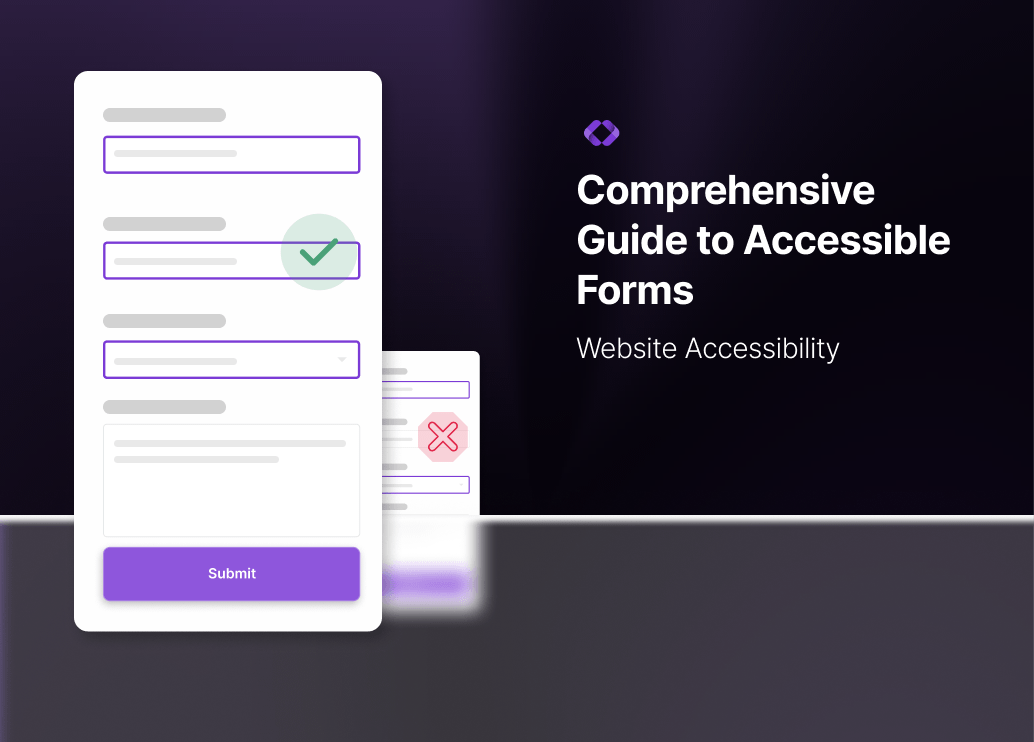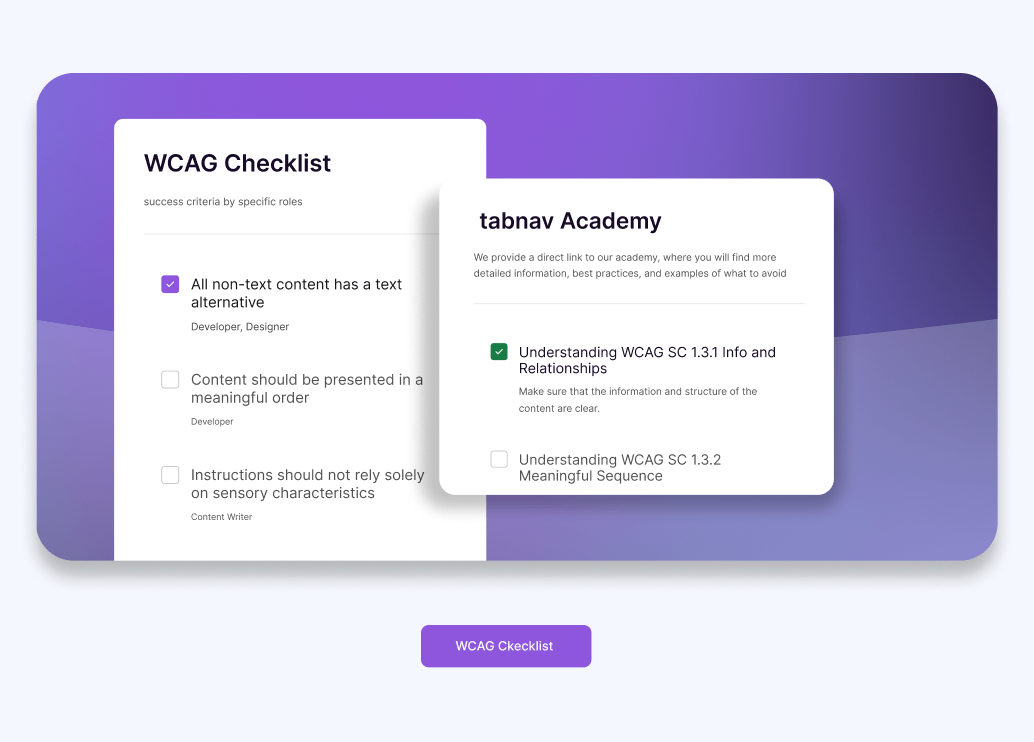Comprehensive Guide to Accessible Forms
August 5, 2024 - Guides & Resources
Free Accessibility Checker
Scan your site for free and identify accessibility issues with tabnav's WCAG checker.
Instant WCAG compliance report
Making Online Forms Work for Everyone: A Practical Approach
Online forms play a critical role in user interactions-whether it's signing up, checking out, or getting in touch. But when forms aren't accessible, they can prevent users with disabilities from completing essential tasks.
Form accessibility is more than a compliance checkbox. It ensures that everyone, regardless of ability, can engage with your content. Creating accessible web forms improves usability, reduces frustration, and helps meet standards like WCAG.
Accessible forms benefit all users. They lower bounce rates, increase conversions, and build trust. An inclusive form design makes it easier for everyone to complete tasks-leading to a better overall experience.
This guide explains the core principles of form accessibility. You'll learn how to make your forms easier to use by checking contrast and supporting keyboard navigation.
We'll also show you how to use clear labels, manage error messages, and keep the tab order logical.

5 Essential Keys to Making Your Forms Accessible
Creating accessible forms is essential for building an inclusive online experience. To make sure all users, including those with disabilities, can use your forms, it's important to check and improve certain parts. Below are five key areas to focus on that will help you make your forms more accessible and user-friendly:
-
Check Contrast
Proper contrast between text and background is essential for form accessibility. You can use tabnav's text contrast checker and link contrast checker to verify that your forms remain accessible and meet WCAG standards-even when background images are involved.
For more detailed guidance, visit tabnav academy's section on "Understanding WCAG SC 1.4.3 Contrast (Minimum)".
-
Test Keyboard Navigation
Accessible web forms must support full keyboard navigation. Users should be able to move through fields, select checkboxes, and submit the form without using a mouse. This is essential for form accessibility, especially for people with motor disabilities. Avoid keyboard traps-make sure users can always move in and out of each element smoothly.
For more detailed guidance, visit tabnav academy's section on "Understanding WCAG SC 2.1.2 No Keyboard Trap".
-
Ensure Clear and Descriptive Labels
Each input field should have a clear and descriptive label that is programmatically associated with the field. This helps screen reader users understand what information is being requested. Placeholder text should not be used as a substitute for labels, as it may not be read by assistive technologies.
-
Provide Error Identification and Suggestions
If a user submits a form with errors, those issues should be clearly identified. Use specific error messages, highlight the affected fields, and move focus to the first error at the top of the form. This helps users correct mistakes efficiently. For full form accessibility, ensure screen readers can announce the errors so users with visual impairments understand what needs to be fixed.
-
Verify Focus Order
The tab order of your form fields should follow a logical, intuitive flow. Focus should move step-by-step through the form, creating a smooth experience for users who rely on keyboard navigation. If the form triggers pop-ups or modals, make sure they are accessible and that focus is correctly managed when they open or close.
Testing Keyboard Navigation Order in Forms
Testing keyboard navigation is a key part of creating accessible web forms. Below, you'll find a simple three-step process to check the focus order in your forms. We've also included interactive examples to show how proper and improper tab order affects usability.
-
Start the Test
Start by clicking on the form title or the first element above it. This sets the initial focus and gives you a clear starting point to test how the focus moves through the form. From there, you can easily spot any issues with the navigation order.
-
Navigate Forward
After setting the starting focus, press the Tab key to move forward through the form fields. Watch how the focus shifts from one field to the next. It should follow a logical top-to-bottom order. If it skips fields or jumps around, there's likely an issue with the navigation order that needs to be fixed for better accessibility.
-
Navigate Backward
Next, press Shift + Tab to move backward through the form. Users should be able to navigate in both directions without issues. Make sure the focus returns to each previous field in order, without skipping any. This helps users correct mistakes easily and keeps the form accessible for everyone.
How to Fix Focus Order Issues
If you've identified that your form has an incorrect focus order, fixing it is essential to ensure that users can navigate your form without confusion or disruption. Here's how you can correct focus order issues:
-
Use the tabindex Attribute: The tabindex attribute controls the order in which elements receive focus when navigating with the Tab key. By setting the tabindex values correctly, you can ensure that users move through the form fields in a logical and intuitive sequence.
-
tabindex="0": Places the element in the natural tab order.
-
tabindex="-1": Removes the element from the tab order.
-
Positive tabindex values (like tabindex="1") let you set a custom tab order. Use them sparingly-overusing them can break the natural flow and confuse users.
-
-
Label Association: Make sure all form elements are properly associated with their labels using the for attribute on labels or by nesting the label around the input. This helps screen readers and other assistive technologies correctly announce the form fields and maintain focus.
-
Testing: After making adjustments, always test the form's focus order again. Use both forward and backward navigation to ensure the changes work as expected.
Free Web Accessibility Checker
Enter your website URL to get a free, instant accessibility scan with tabnav's checker.
Essential Form Validation Tips for Better Web Accessibility
Form validation is essential for ensuring that users provide the necessary information accurately and efficiently. Effective validation not only maintains data integrity but also significantly improves the user experience, especially for individuals with disabilities. In this section, we will delve into the critical aspects of accessible form validation and provide practical steps to test and optimize your forms for all users.
Key Elements of Accessible Form Validation
-
Clear Error Labels Indicating What Is Missing
Error labels must explicitly state what information is missing or incorrectly entered. Instead of vague messages like "Error" or "Invalid input," use specific descriptions such as "Email address is required" or "Password must be at least 8 characters." This clarity helps all users, including those with cognitive disabilities, understand exactly what needs to be corrected.
-
Error Messages Recognized by Screen Readers
Ensure that error messages are properly coded to be detected and announced by screen readers. Utilize ARIA (Accessible Rich Internet Applications) attributes like aria-live="assertive" to make sure that error messages are announced immediately when they appear. This real-time feedback is crucial for users with visual impairments, allowing them to quickly identify and address issues without confusion.
-
Focus Management Directing to the Relevant Input
When an error occurs, the focus should automatically move to the first input field with an error. This assists users who rely on screen readers by directing them to the exact location that needs attention, minimizing frustration and streamlining the correction process. Proper focus management ensures a smooth and efficient user experience, enabling users to navigate and fix errors with ease.
Testing Form Validation
To ensure that your form validation is accessible, follow these three testing steps on the form validation example provided below. This example demonstrates how accessible form validation should work, and the instructions below will guide you through the process of testing its effectiveness.
-
Click Submit to See the Error Messages
Start by attempting to submit the form without filling in any fields. Observe the error messages that appear. Ensure that each message clearly indicates what information is missing or incorrect, providing specific guidance on how to fix the issue. This helps users understand exactly what needs to be addressed before proceeding.
-
Fill Out the Bottom Form Inputs and Leave Others Empty
Populate some fields, particularly those at the bottom of the form, while leaving others empty. Then click submit and observe how the focus is directed. The focus should return to the first input with an error, typically starting from the top, to help users identify and correct the issues in a logical order. This ensures that users are guided through the form in a structured manner.
-
Verify Screen Reader Announcements and Keyboard Navigation
Use a screen reader to navigate through the form and trigger validation errors. Ensure that error messages are announced correctly and that the focus shifts to the appropriate input fields. Additionally, test keyboard navigation to make sure that users can easily move between fields and access error messages without relying on a mouse. This step confirms that both visual and non-visual users receive the necessary feedback to complete the form successfully.
Ensuring your forms are accessible is a vital step in creating an inclusive website. By following the best practices outlined above, you can help ensure that all users, regardless of their abilities, can interact with your website smoothly. At tabnav, we offer free guidance and assistance with forms and web accessibility. Feel free to contact us today with any questions, and let us help you make your website a more welcoming place for everyone.

Hello! I'm Eli Dror
Website accessibility expert with 4+ years of experience. Specializes in WCAG audits, accessible design, and inclusive user experience strategies.
@elielidror




